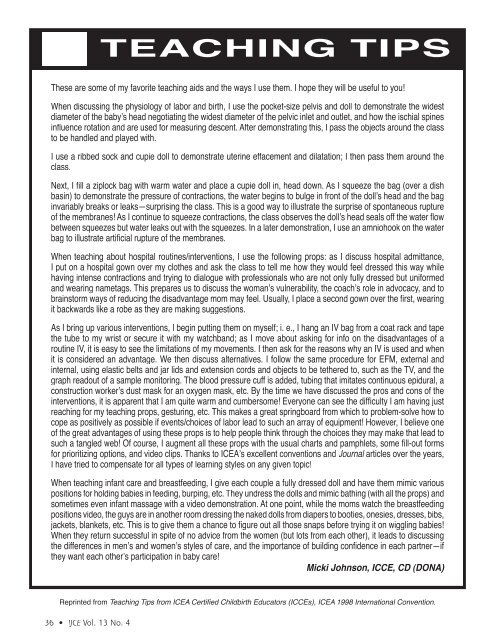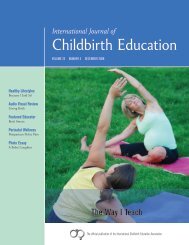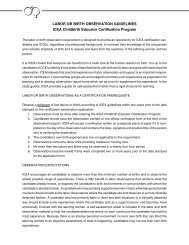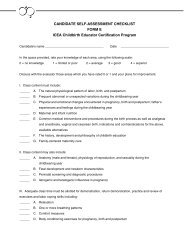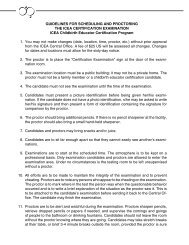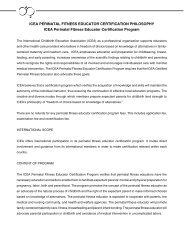JOURNAL - International Childbirth Education Association
JOURNAL - International Childbirth Education Association
JOURNAL - International Childbirth Education Association
You also want an ePaper? Increase the reach of your titles
YUMPU automatically turns print PDFs into web optimized ePapers that Google loves.
TEACHING TIPS<br />
These are some of my favorite teaching aids and the ways I use them. I hope they will be useful to you!<br />
When discussing the physiology of labor and birth, I use the pocket-size pelvis and doll to demonstrate the widest<br />
diameter of the baby’s head negotiating the widest diameter of the pelvic inlet and outlet, and how the ischial spines<br />
infl uence rotation and are used for measuring descent. After demonstrating this, I pass the objects around the class<br />
to be handled and played with.<br />
I use a ribbed sock and cupie doll to demonstrate uterine effacement and dilatation; I then pass them around the<br />
class.<br />
Next, I fi ll a ziplock bag with warm water and place a cupie doll in, head down. As I squeeze the bag (over a dish<br />
basin) to demonstrate the pressure of contractions, the water begins to bulge in front of the doll’s head and the bag<br />
invariably breaks or leaks—surprising the class. This is a good way to illustrate the surprise of spontaneous rupture<br />
of the membranes! As I continue to squeeze contractions, the class observes the doll’s head seals off the water flow<br />
between squeezes but water leaks out with the squeezes. In a later demonstration, I use an amniohook on the water<br />
bag to illustrate artifi cial rupture of the membranes.<br />
When teaching about hospital routines/interventions, I use the following props: as I discuss hospital admittance,<br />
I put on a hospital gown over my clothes and ask the class to tell me how they would feel dressed this way while<br />
having intense contractions and trying to dialogue with professionals who are not only fully dressed but uniformed<br />
and wearing nametags. This prepares us to discuss the woman’s vulnerability, the coach’s role in advocacy, and to<br />
brainstorm ways of reducing the disadvantage mom may feel. Usually, I place a second gown over the first, wearing<br />
it backwards like a robe as they are making suggestions.<br />
As I bring up various interventions, I begin putting them on myself; i. e., I hang an IV bag from a coat rack and tape<br />
the tube to my wrist or secure it with my watchband; as I move about asking for info on the disadvantages of a<br />
routine IV, it is easy to see the limitations of my movements. I then ask for the reasons why an IV is used and when<br />
it is considered an advantage. We then discuss alternatives. I follow the same procedure for EFM, external and<br />
internal, using elastic belts and jar lids and extension cords and objects to be tethered to, such as the TV, and the<br />
graph readout of a sample monitoring. The blood pressure cuff is added, tubing that imitates continuous epidural, a<br />
construction worker’s dust mask for an oxygen mask, etc. By the time we have discussed the pros and cons of the<br />
interventions, it is apparent that I am quite warm and cumbersome! Everyone can see the difficulty I am having just<br />
reaching for my teaching props, gesturing, etc. This makes a great springboard from which to problem-solve how to<br />
cope as positively as possible if events/choices of labor lead to such an array of equipment! However, I believe one<br />
of the great advantages of using these props is to help people think through the choices they may make that lead to<br />
such a tangled web! Of course, I augment all these props with the usual charts and pamphlets, some fill-out forms<br />
for prioritizing options, and video clips. Thanks to ICEA’s excellent conventions and Journal<br />
articles over the years,<br />
I have tried to compensate for all types of learning styles on any given topic!<br />
When teaching infant care and breastfeeding, I give each couple a fully dressed doll and have them mimic various<br />
positions for holding babies in feeding, burping, etc. They undress the dolls and mimic bathing (with all the props) and<br />
sometimes even infant massage with a video demonstration. At one point, while the moms watch the breastfeeding<br />
positions video, the guys are in another room dressing the naked dolls from diapers to booties, onesies, dresses, bibs,<br />
jackets, blankets, etc. This is to give them a chance to figure out all those snaps before trying it on wiggling babies!<br />
When they return successful in spite of no advice from the women (but lots from each other), it leads to discussing<br />
the differences in men’s and women’s styles of care, and the importance of building confidence in each partner—if<br />
they want each other’s participation in baby care!<br />
Micki Johnson, ICCE, CD (DONA)<br />
Reprinted from Teaching Tips from ICEA Certifi ed <strong>Childbirth</strong> Educators (ICCEs), ICEA 1998 <strong>International</strong> Convention.<br />
36 • IJCE Vol. 13 No. 4


